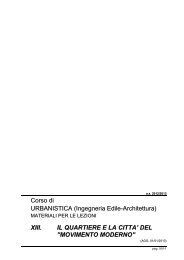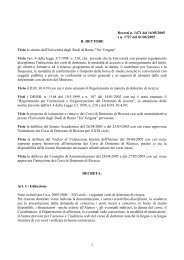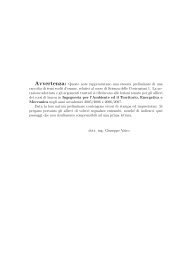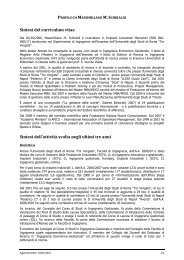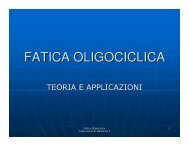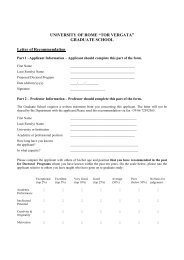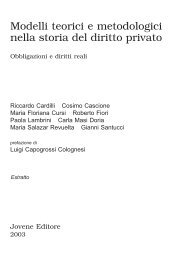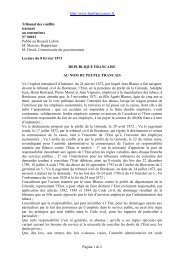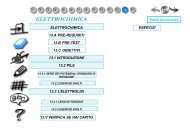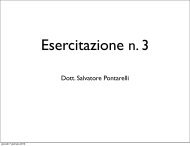Create successful ePaper yourself
Turn your PDF publications into a flip-book with our unique Google optimized e-Paper software.
the plant means hand pulling or grubbing. Hand pulling<br />
works are easier with wet soils and with small infestations.<br />
It is best to pull or grub out the plant prior to<br />
flowering (Parsons, 1973). If extensive areas are covered<br />
by <strong>hemlock</strong>, chemical control is simpler. In this case one<br />
can use a synthetic auxin-like compound, such as 2,4-D<br />
(2,4-dichloro-phenoxy-acetic acid), which practically<br />
does not kill grasses (few exceptions are only). However,<br />
<strong>hemlock</strong> is a prolific seed producer, and a repeated in<br />
next year may be needed to achieve complete control. In<br />
alfalfa the poison <strong>hemlock</strong> can be controlled with other<br />
selective herbicide such as hexazone (Panter and Keeler,<br />
1989).<br />
Some management guidelines can be followed to<br />
minimalize chance and probability of plant toxicosis.<br />
One should prevent the pregnant animals from grazing<br />
the plant prior to day 70 of gestation in the cow or day<br />
60 in the pig, because these are the critical stages when<br />
developmental problems may occur.<br />
8. Economic importance<br />
<strong>Poison</strong>ing of animals by poison <strong>hemlock</strong> can cause<br />
great losses. The losses can be direct (death, performance<br />
and reproduction losses; Panter et al., 2002) and<br />
indirect ones (costs incurred by a livestock enterprise in<br />
trying to prevent poisoning or costs incident to poisoning).<br />
The economic losses can only be estimated,<br />
because most deaths from plants go undiagnosed and<br />
unreported. <strong>Conium</strong> <strong>maculatum</strong> contributes to the<br />
overall livestock loss from poisonous plants, estimated<br />
to be over $100 million annually in the United States<br />
(Nielsen and James, 1985; James et al., 1992).<br />
9. Conclusions<br />
(1) <strong>Conium</strong> <strong>maculatum</strong> is a very common weed species<br />
of invasive character, i.e. the habitat of the plant is<br />
increasing. The plant grows first of all on soil with<br />
higher or nitrogen content, it is said to be a nitrophile<br />
species. Its chemical control (for example by auxin-like<br />
compounds) seems to be the most economic and relative<br />
safe method.<br />
(2) <strong>Conium</strong> <strong>maculatum</strong> has a very significant capacity<br />
to synthesize the alkaloids of piperidine type. The main<br />
component is coniine the production of which is localized<br />
in different types of plant tissues.<br />
(3) There are two types of animal poisoning: the acute<br />
and the chronic ones. The acute type is observed when<br />
the animals ingest some vegetative parts or seeds of<br />
plant. The alkaloids produce a neuromusculare blockage<br />
which can stop the function of the respiratory<br />
muscles. The chronic toxicity affect the pregnant animals<br />
J. Vetter / Food and Chemical Toxicology 42 (2004) 1373–1382 1381<br />
only, the offspring is born with different malformations<br />
(mainly with MCC ¼ multiple congenital contractures).<br />
(4) The cause of a human toxicosis is probably usually<br />
the mistaken ingestion of the plant (fresh leaves or<br />
seeds). The seriousness of <strong>hemlock</strong> poisoning and the<br />
prospects of recovery are determined by ingested quality,<br />
alkaloid concentration and the general condition of<br />
the organism. The probability of a mistaken ingestion of<br />
the plant can minimised by better management and<br />
control as well as by a better identification of the plant.<br />
(5) The economic (direct and indirect) losses, caused<br />
by <strong>hemlock</strong> poisoning, are not negligible, there are<br />
numerous tasks for the experts.<br />
References<br />
Ahmed, M., Ashraf, M., Akbar, G., 1989. <strong>Poison</strong>ous and injurious<br />
range plants in Pakistan. Progressive Farming 9, 41–44.<br />
Baskin, M., Baskin, C., 1990. Seed germination ecology of poison<br />
<strong>hemlock</strong>, <strong>Conium</strong> <strong>maculatum</strong>. Canadian Journal of Botany 68,<br />
2018–2024.<br />
Berenbaum, R., Harrison, L., 1994. Agonopterix alstroemeriana<br />
(Oecophoridae) and other lepidopteran associates of poison <strong>hemlock</strong><br />
(<strong>Conium</strong> <strong>maculatum</strong>) in east central Illinois. Great Lakes<br />
Entomologist 27, 1–5.<br />
Biberci, E., Altuntas, Y., Cobanoglu, A., Alpinar, A., 2002. Acute<br />
respiratory arrest following <strong>hemlock</strong> (<strong>Conium</strong> <strong>maculatum</strong>) intoxication.<br />
Journal of Toxicology––Clinical Toxicology 40, 517–518.<br />
Bowman, C., Snaghvi, S., 1963. Pharmacological actions of <strong>hemlock</strong><br />
(<strong>Conium</strong> <strong>maculatum</strong>) alkaloids. Journal Pharmacoeutical Pharmacology<br />
15, 1–25.<br />
Cooper, R., Johnson, W., 1984. <strong>Poison</strong>ous plants in Britain and their<br />
effects on animals and man. Her Majesty’s Stationery Office,<br />
London, p. 305.<br />
Copithorne, B., 1937. Suspected poisoning of goats by <strong>hemlock</strong><br />
(<strong>Conium</strong> <strong>maculatum</strong>). Veterinary Record 49, 1018–1019.<br />
Corsi, G., Biasci, D., 1998. Secretory structures and localisation of<br />
alkaloids in <strong>Conium</strong> <strong>maculatum</strong> L. (Apiaceae). Annals of Botany<br />
81, 157–162.<br />
Cromwell, J., 1956. The separation, microestimation and distribution<br />
of alkaloid of poison <strong>hemlock</strong> (<strong>Conium</strong> <strong>maculatum</strong>). Biochemical<br />
Journal 64, 259–266.<br />
Drummer, H., Roberts, N., Bedford, J., Crump, L., Phelan, H., 1995.<br />
Three deaths from <strong>hemlock</strong> poisoning. The Medical Journal of<br />
Australia 162, 592–593.<br />
Fairbairn, W., Challen, B., 1959. The alkaloids of <strong>hemlock</strong> (<strong>Conium</strong><br />
<strong>maculatum</strong> L.) distribution in relation to the development of the<br />
fruit. Biochemical Journal 72, 556–561.<br />
Fairbairn, W., Suwal, N., 1961. The alkaloids of <strong>hemlock</strong> (<strong>Conium</strong><br />
<strong>maculatum</strong> L.) II. Evidence for a rapid turnover of the major<br />
alkaloids. Phytochemistry 1, 38–46.<br />
Forsyth, S., Frank, A., 1993. Evaluation of developmental toxicity of<br />
coniine to rats and rabbits. Teratology 48, 59–64.<br />
Frank, A., Reed, M., 1987. <strong>Conium</strong> <strong>maculatum</strong> (poison <strong>hemlock</strong>)<br />
toxicosis in a flock of range turkeys. Avian Diseases 31, 386–388.<br />
Frank, A., Reed, M., 1990. Comparative toxicity of coniine, an<br />
alkaloid of <strong>Conium</strong> <strong>maculatum</strong> (poison <strong>hemlock</strong>), in chickens,<br />
quails and turkeys. Avian Diseases 34, 433–437.<br />
Frank, S., Michelson, B., Panter, E., Gardner, R., 1995. Ingestion of<br />
poison <strong>hemlock</strong> (<strong>Conium</strong> <strong>maculatum</strong>). West Journal of Medicine<br />
163, 573–574.<br />
Galey, D., Holstege, M., Fisher, G., 1992. Toxicosis in dairy cattle<br />
exposed to poison <strong>hemlock</strong> (<strong>Conium</strong> <strong>maculatum</strong>) in hay: isolation



